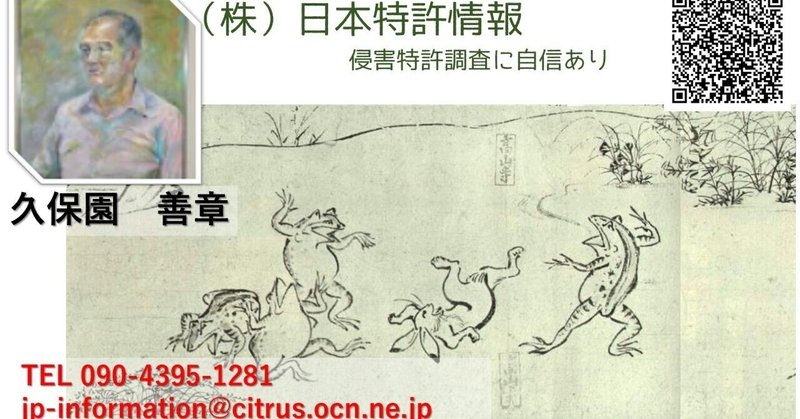
(裁判-2) 裁判所の判決文で、知的財産高等裁判所で下された判例です。
https://drive.google.com/file/d/1UK1LJjGurfv51MCahGSW5HshyDADkB7C/view?usp=sharing
https://drive.google.com/file/d/1RB7w8SXZY19X9oqQrA_pNAYupHyZtk54/view?usp=sharing
https://drive.google.com/file/d/1Vm4OU3DgmdkJFeHUuNcV6JBjp-yZM0ua/view?usp=sharing
https://drive.google.com/file/d/1Ha-yXqB0IAvfR01Pe2L8jBzro5tWgEZp/view?usp=sharing
平成19年(ネ)第10010号(判決言渡 平成20年10月27日)で、特許3457107を「権利無効」としたものです。
判決文の実質ページ数は62枚で、残りは(別紙)です。こちらは各ページの下段に「ページ数」が付されています。
昨日アップしました東京地方裁判所の判決文と同様で、所謂「紐無し褌文(ひも無しふんどし文)」で、プレーヤーが控訴人、被控訴人および裁判所の3名、そして「特許明細書」や「審決」など、更には「別紙」などのファクトがあります。
本件も、控訴人、被控訴人の代理人数が少なく、フロントページに「主文」が書かれているケースです。
(本来ならば、代理人は原告・被告とも1名の記載だけで十分と思われます)。
判決文を読んで、理解するには、先ずは「段落の無い文章」の慣れることです。
先ずは、「PDF」と「テキスト」文章を入手し、これに「ハイライト記号」(多色)を付して、文章を解剖する必要があります。
そして、ファクトの部分を飛ばして、「控訴人の主張」、「非控訴人の主張」、そして肝心な「当裁判所の判断」のところを色分けして、読み込みます。
2ページ目の判決抜粋に要約をしましたが、「第1 控訴人が求めた裁判」、「第2 事案の概要」、「第3 当事者の主張」、そして「第4 当裁判所の判断」が容易に理解できると思います。
何はともあれ、知的財産高等裁判所の判断の後段の「結論」のところの要部を切り取ります。
ところで、知財部門に配属されている技術系の担当者は、常日頃からこの「ふんどし文」である裁判記録に慣れるようにすべきです。(慣れてしまえば、こっちのものです)。
なおここで、「裁判文章の標準的な書式、標記法」を添付します。
https://drive.google.com/file/d/1drJUcrWJKef1ureMAiik8fLyLDFtYybP/view?usp=sharing
(Google Translation)
(Court-2) This is a court judgment and is a precedent handed down by the Intellectual Property High Court. No. 10010 of 2007 (judgment handed down on October 27, 2008), patent 3457107 was declared invalid.
The actual number of pages in the judgment is 62, with the remaining pages being attached.
The page number is indicated at the bottom of each page.
It is similar to the Tokyo District Court's judgment that was uploaded yesterday, and it is a so-called "stringless loincloth pattern" in which the players are the appellant, the appellee, the court, and the "patent specification".
There are facts such as "trial decision" and even "annex".
This case is also a case where the number of attorneys for the appellant and the appellee is small, and the ``main text'' is written on the front page. (Originally, it would be sufficient to list only one agent for both the plaintiff and the defendant.)
In order to read and understand judgments, you must first become familiar with ``sentences without paragraphs.''
First, you need to obtain the "PDF" and "text" sentences, add "highlight marks" (multicolor) to them, and dissect the sentences.
Then, you can skip the fact section and read the ``appellant's assertion'', ``non-appellant's assertion'', and the important ``judgment of this court'' in different colors.
I have summarized it in the excerpt of the judgment on the second page, which includes "No. 1: The trial sought by the appellant," "No. 2: Outline of the case," "No. 3: Allegations of the parties," and "No. 4: Judgment of this court."
I think it's easy to understand. In any case, I will cut out the main part of the ``Conclusion'' section at the end of the Intellectual Property High Court's judgment.
By the way, technical personnel assigned to the intellectual property department should regularly become familiar with court records, which are "loincloth documents."
(Once you get used to it, it's here).
At this point, we have attached the "Standard Format and Notation for Judgment Texts."
(Google 翻译)
(Court-2)这是法院判决,是知识产权高等法院颁布的先例。
2007年第10010号专利(2008年10月27日判决),宣告第3457107号专利无效。
判决书实际页数为62页,其余页数附后。
页码显示在每页底部。 与昨天上传的东京地方法院的判决书类似,都是由上诉人、被上诉人、法院、 “专利说明书”扮演者的所谓“无绳缠腰布图案”,有事实依据例如“审判决定”甚至“附件”。
本案也是上诉人和被上诉人律师人数较少,且“正文”写在首页的案件。
(原本,原告和被告只列出一名代理人就足够了。)
为了阅读和理解判断,你必须首先熟悉“没有段落的句子”。
首先,您需要获取“PDF”和“文本”句子,为其添加“突出显示标记”(多色),并对句子进行剖析。
然后,你可以跳过事实部分,阅读不同颜色的“上诉人主张”、“非上诉人主张”以及重要的“本院判决”。
我在第二页的判决书摘录中总结了这一点,其中包括“第一条:上诉人寻求的审理”、“第二条:案件概要”、“第三条:当事人的指控” ”和“第四号:本院判决”我觉得很容易理解。
无论如何,我会删掉知识产权高等法院判决书最后“结论”部分的主要部分。
顺便说一句,分配到知识产权部门的技术人员应该定期熟悉法庭记录,这些记录是“腰布文件”。
(一旦你习惯了,它就在这里)。
至此,我们附上了《判决书的标准格式及表示法》。
(ハッシュタグ)
#INPIT #JPlatPat #仕事について話そう #note #note毎日更新 #note毎日投稿 #note連続更新 #note連続投稿 #noteクリエイター #note応援部 #note毎日 #note海外組 #noteメンバーシップ #note日記 #note更新 #noteサークル #仕事 #仕事のコツ #仕事のポリシー #仕事論 #仕事効率化 #仕事観 #仕事ができる人 #仕事の話 #仕事内容 #仕事の仕方 #仕事の進め方 #仕事を楽しむ #仕事とは #仕事力 #ビジネス #ビジネススキル #ビジネスモデル #ビジネスチャンス #知財 #知財戦略 #知財塾 #知的財産 #知的財産権 #知的財産高等裁判所 #特許 #特許調査 #特許法 #特許庁 #特許事務所 #特許分類 #特許検索 #特許分析 #特許情報 #特許権者 #特許無効審判 #専利 #分類付与 #先行技術調査 #無効資料調査 #侵害調査 #侵害予防調査 #パテント #発明 #発明塾 #どうする特許庁 #検索論理式 #審査官 #審判官 #AI #AIの活かし方 #AI画像生成 #IT #ITエンジニア #IT業界 #IT企業 #ITベンチャー #IT化 #IT系 #ITリテラシー #ITツール #DX #DX化 #DX推進 #DX人材 #DX事例 #DXリテラシー #Patent #ChatGPT #ChatGPTの使い方 #ChatGPTが凄い #ChatGPTに聞いてみた #Gemini #Threads #bing #bingAI #bingX #金子吉友 #一月万冊 #裁判所 #出願情報 #東京地方裁判所
この記事が気に入ったらサポートをしてみませんか?
